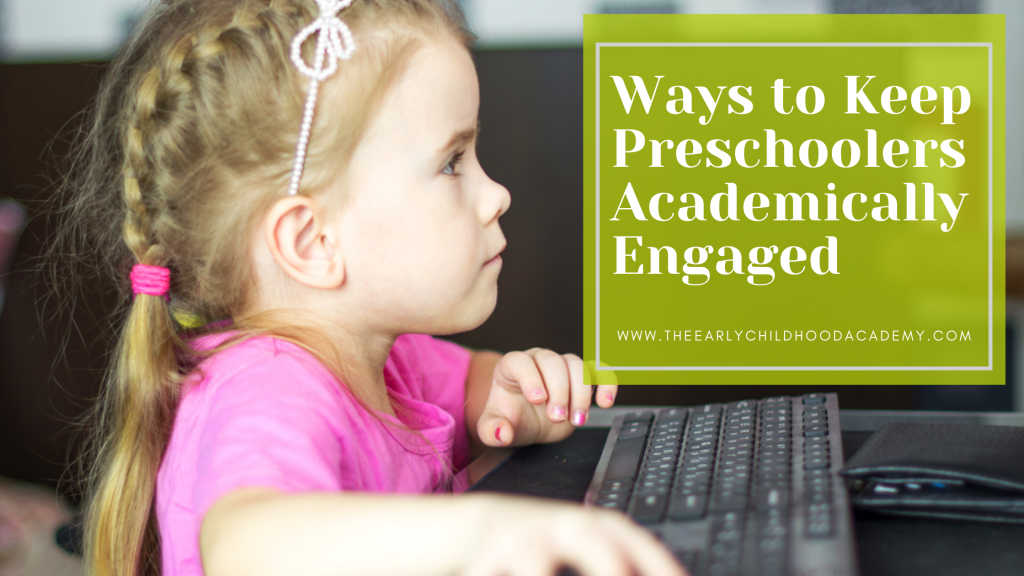Written by Janine Byler
The pandemic has forced schools around the world to transition to online learning, leaving 1.6 billion children out of school. This sudden shift may have come as more of a shock to preschoolers — who are experiencing the health crisis during their formative years. Fortunately, child care programs are slowly opening back up, allowing some kids to experience face-to-face classes. However, regardless if you’re teaching in person or virtually, your top priority is still to provide a meaningful educational experience. With that, here are a few ways you can keep your preschoolers academically engaged online and offline.
Always be well-prepared
 Having everything ready for class is the first step to making sure your students are engaged during lessons. You’ll want to make sure that you’ve brought everything needed for that class. If you have time before class starts, prepare anything that’s needed — be it coloring materials or props for story time. If you have audio-visual lessons, make a shortcut on your laptop that you can access quickly. After all, children don’t have a very long attention span, so they won’t have the patience to wait while you search for the correct item. If you’re still using virtual learning platforms, ask help from a friend so you can do a trial run of your lessons and choose the right online learning platform to make the experience as fuss-free as possible. Nowadays, there are websites for every kind of class, from virtual skills learning to short courses with certifications. Of course, this will be different for your preschoolers, so be sure to choose one that’s easy to navigate for you and your students.
Having everything ready for class is the first step to making sure your students are engaged during lessons. You’ll want to make sure that you’ve brought everything needed for that class. If you have time before class starts, prepare anything that’s needed — be it coloring materials or props for story time. If you have audio-visual lessons, make a shortcut on your laptop that you can access quickly. After all, children don’t have a very long attention span, so they won’t have the patience to wait while you search for the correct item. If you’re still using virtual learning platforms, ask help from a friend so you can do a trial run of your lessons and choose the right online learning platform to make the experience as fuss-free as possible. Nowadays, there are websites for every kind of class, from virtual skills learning to short courses with certifications. Of course, this will be different for your preschoolers, so be sure to choose one that’s easy to navigate for you and your students.
Let the children guide you
A child can engage with anything they find interesting. Ask the children what things they like and what they enjoy doing, then try a few activities in your sessions to see what they pay attention to the most. For example, if you know the children like the beach, you can read some books or have them watch videos about the ocean and sea animals. But remember to find easy materials that preschoolers can understand. Perhaps you could even set aside some time to walk around the campus or at a park so that the children can explore. See where they naturally wander off to and what captures their attention. Is it trees? Animals? The sky? This may take some trial and error (and patience!), but once you know their interests, it’s easier to think of what you should be incorporating more in your lessons.
Have interactive lessons
 If you’re still using virtual platforms, pre-recorded lessons may be convenient for you, but this passive screen time will easily make your preschoolers lose interest. Not to mention, you’ll lose your connection with them as well. For instance, instead of simply reading them a story, you can opt to do a simple puppet show to keep them engaged. Likewise, you can incorporate some music and songs to encourage interaction. Another option is to sing songs that are familiar to them and invite them to follow along with you. Or, you can always use online learning resources, such as the Jack Hartmann Kids Music Channel and Dr. Jean on YouTube, which are dedicated to getting children engaged. When inside the classroom, try activities that let them get creative, such as good old arts and crafts. Whatever your lesson, keep it visual and interactive so they’re having fun while learning.
If you’re still using virtual platforms, pre-recorded lessons may be convenient for you, but this passive screen time will easily make your preschoolers lose interest. Not to mention, you’ll lose your connection with them as well. For instance, instead of simply reading them a story, you can opt to do a simple puppet show to keep them engaged. Likewise, you can incorporate some music and songs to encourage interaction. Another option is to sing songs that are familiar to them and invite them to follow along with you. Or, you can always use online learning resources, such as the Jack Hartmann Kids Music Channel and Dr. Jean on YouTube, which are dedicated to getting children engaged. When inside the classroom, try activities that let them get creative, such as good old arts and crafts. Whatever your lesson, keep it visual and interactive so they’re having fun while learning.
Keep your sessions short
No matter how engaging your lesson is, it’s a matter of fact that preschoolers have an attention span of up to about only 12 minutes. After this, they’ll be too restless to pay attention to your lesson. And it won’t do any good to rush a lesson within that time. As such, it’s better to keep your meetings short but digestible. If you’re online, do one or two activities then log off. But don’t assign too much homework in exchange for the short class time either. If you’re in a physical classroom, be sure to take breaks once in a while. If you’re not sure how long you should be doing something, watch the kids closely. If you notice most of them start to be restless and distracted from what they’re doing, that’s a good time to either do a different activity or take a break.
Do some exercises
 Whether you need an idea for an activity or want the kids to take a break, movement breaks are great for both face-to-face classes and virtual learning. As the name suggests, these are breaks where you encourage your preschoolers to move and be physically engaged. Consider games like Six Spots and Trading Places, which let them move around the room and interact with classmates. Meanwhile, Animal Pretend and 5-4-3-2-1 are very doable even with online classes.
Whether you need an idea for an activity or want the kids to take a break, movement breaks are great for both face-to-face classes and virtual learning. As the name suggests, these are breaks where you encourage your preschoolers to move and be physically engaged. Consider games like Six Spots and Trading Places, which let them move around the room and interact with classmates. Meanwhile, Animal Pretend and 5-4-3-2-1 are very doable even with online classes.
Not all children are experiencing education in a pandemic the same way. But whether you’re teaching classes face-to-face or virtually, it’s important to be patient with your preschoolers and with yourself as well. What matters is you’re doing your best to still give the children the education they need.
Use Things They Love As Reference Points And Examples
Most people work best when they are able to reference things they know about or care about. Whether they work in an office or are studying for a test, they need to think about something they can relate to. The same can be said about young children. When teaching kids about almost anything, you can bring something they care about into the equation. They’ll become more engaged because they’re now talking about their hobby or passion. They’ll learn with a smile on their faces. As they grow, they might use this kind of thing going forward. Whether they study from an online charter school or attend regular schooling every day, they’ll have a platform to understand things. They won’t just do the same, traditional methods of writing things down and copying out of textbooks every single time.

